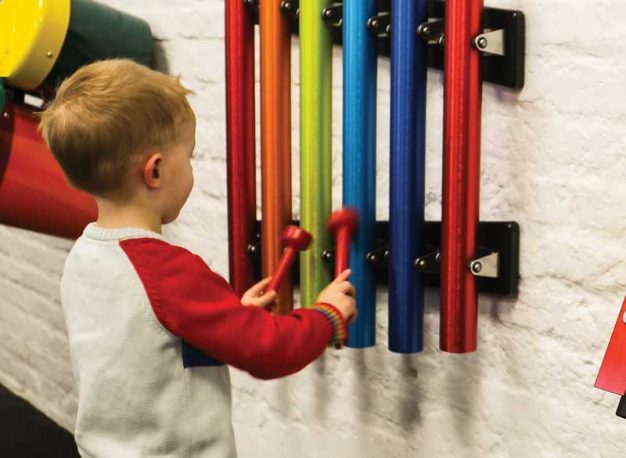
Musical instruments help improve children’s core stability
With a lot of focus on children being academically ready for school, going back to basics and helping a child to be physically ready is a step that many schools, preschools, and other childcare settings think about throughout the school year. Play, especially outdoor play, is critical for helping children develop skills that will benefit them academically.
For instance, developing the physical skills of balance and a strong core will have endless benefits for a child, not only making them a more coordinated individual but enhancing their ability to engage in learning for longer periods. Outdoor music can be a useful tool to aid the development of physical skills, as well as being proven to support communication, encourage expression, and build self-esteem.
Strengthening the core of W-sitters and slouchers
We have all encountered the “W sitter,” the child who is constantly in that knees-and-bottom, wide-based position. While the child feels stable, this position does not allow for much trunk rotation – a skill needed for running, manipulating objects and negotiating space. How about the child who is always flopped over to one side or is constantly adjusting their position during carpet time? All of these clues indicate a lack of core strength.
Standing to play a large instrument, like Percussion Play’s Akadinda, engages gross motor skills to play the notes up and down a long length, which helps to improve the child’s core strength and their range of bilateral movements. This fun activity may, in time, develop the child’s core strength – allowing them to feel more stable in an alternative seated position.
Developing core “Crossing the Midline” skills
Activities that encourage crossing the midline can aid in a child’s physical development. Imagine an invisible line drawn down the center of your body. Now imagine drawing a long horizontal line on a piece of paper. Can you complete this task, crossing that imaginary vertical line with your dominant hand, without passing the pencil into the other hand?
What seems like a simple task can be tricky for those who are not used to crossing the midline – those children you have observed reaching for items on the right side of their body with their right hand, and the left with the left. Perhaps they constantly swap hands while mark making. This difficulty crossing that imaginary line can slow the development of a dominant hand. Many other everyday tasks are dependent on crossing the midline, so this is an important skill to master.
In order for children to become confident with movements that cross the midline, we need to encourage the two hemispheres of the brain to work together and help develop a child’s core strength. Playing an instrument that encourages the child to reach, move their arms across their body or play from one side of the body to the other promotes communication between those two sides of the brain. With time, the child will be able to do this spontaneously and the need to swap hands will reduce.
Other activities that encourage crossing the midline include:
- Wiping the table
- Pushing cars along a track
- Painting a large space, like a fence or wall, using water and adult-size paintbrushes
With each of these activities, the child should be encouraged to use one hand at a time and cross the midline repeatedly.
Musical instruments develop skills for the classroom
What about that child who struggles to grip their pencil, or pull up the zipper on their coat? The gross motor skills used to manipulate the large mallets of an outdoor musical instrument could improve muscle tone and encourage a preference for a dominant hand. These large movements could then be gradually reduced to the fine motor skills required inside the classroom.
Outdoor music and play are great for building a child’s body awareness, engaging the vestibular system, responsible for balance and spatial awareness, and increasing the child’s confidence in movement. The large-scale movements fostered during outdoor play help to improve a child’s proprioception – the ability to sense their bodies orientation and its relation to objects in their environment.
Having instruments resistant to weather means that they can be left in the play space year-round, enhancing continuous provision and allowing children to develop their skills in their independent learning time.
Outdoor music lends itself to endless openings for learning through play.
The power of percussion play
Percussion Play creates exciting, outdoor musical instruments for all ages and abilities to explore – bringing the joy of playing percussion to the great outdoors. Specifically designed for challenging outdoor environments including; playgrounds, parks, trails, schools, family attractions, hospitals & elder centers, the instruments are fully inclusive, accessible and enjoyed by all who encounter them.
As well as designing and manufacturing outdoor musical instruments, Percussion Play has compiled an online knowledge base which hosts articles detailing the varied benefits of musical and outdoor play and White Papers on various music, play and, health-related topics.




